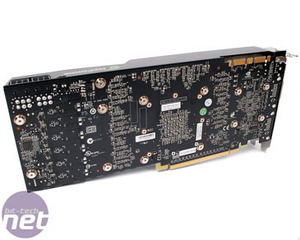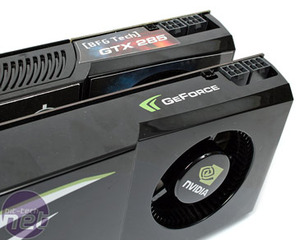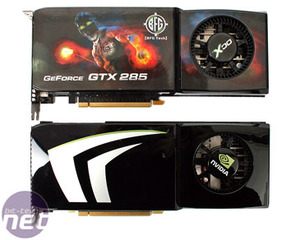Radeon HD 4890 vs GeForce GTX 275
April 3, 2009 | 16:03

ATI Radeon HD 4890 1GB
Manufacturer: AMDUK Price (as reviewed): Typical price £220 (inc. VAT)
US Price (as reviewed): Typical price $249.99 (ex. Tax)
Nvidia GeForce GTX 275 896MB
Manufacturer: NvidiaUK Price (as reviewed): £220 (inc. VAT)
US Price (as reviewed): MSRP $249 (ex. Tax)
Introducing the new competition from ATI and Nvidia
It’s been a while since we’ve seen ATI and Nvidia scrap it out with two comparably priced cards launching on the same day, but this month they’re right back at it. The Radeon HD 4890 is best seen as an overclocked 1GB Radeon HD 4870 – the architecture is the same and it’s still built using a 55nm process, but ATI has slightly stretched the design to widen the internal copper interconnects and put a crucial few more atoms of silicon between the transistors. The stretched design reduces transistor power leakage and strengthens signal integrity, which in turn allows the chip to run at higher frequencies.Stock clocked Radeon HD 4890s ship with a GPU clocked at 850MHz, which is 100MHz faster than the Radeon HD 4870's engine clock, and the Qimonda GDDR5 memory is now running at 975MHz (3.9GHz effective) rather than 900MHz (3.6GHz effective). ATI claims that the RV790 GPU can be easily overclocked to 1GHz and beyond (with watercooling), however we're dubious about how much the stock cooler can take.

With the new GeForce GTX 275, Nvidia is sticking to its strategy of modifying its 55nm GT200 GPU to suit whichever price point it fancies hitting. The GTX 275 therefore has 240 stream processors and a 448-bit memory interface. This means that the GTX 275 is very similar to the GPUs used in the GeForce GTX 295, differing only in clock speeds.
The twin GPUs in the GTX 295 operate at 576MHz, compared to the GTX 275 which is clocked at 633MHz and likewise the stream processors of the GTX 295 GPUs run at 1,242MHz, rather than 1,404MHz in the GTX 275. Memory is still limited to GDDR3, and the GTX 275 has 896MB of it running at 1,134MHz (2,268MHz effective) rather than the 999MHz (1,998MHz effective) GDDR3 memory of the GTX 295. Why is the GTX 275 GPU faster than those of the GTX 295? Because it has a dedicated dual slot heatsink for just one GPU, it has two 6-pin power connectors all to itself and it has more PCB space for better power hardware underneath as well.
In terms of price, neither of these new cards will break the bank. Both cards cost roughly £220, give or take a few pounds. However, Palit has produced an own-design version of the GTX 275 for £199.99 inc. VAT on launch day. As we were given a reference card to test, all of the following data cannot be applied to this Palit card, and so any price/performance comparisons we make in this article will be made on the prices given for reference design GTX 275 cards.
To see how the two new GPUs stack up in the line-ups of the two graphics companies, we've knocked together the handy specs table above, and we've also got some details for a few partner cards over the next two pages. Unfortunately Nvidia was less "ready" than AMD at this launch, playing role of the reactionary party and only a reference card was available to us in time for the launch. In comparison, no less than five AMD partners got us Radeon HD 4890 cards for launch day, however one had an issue with its artwork (no, not a "wardrobe malfunction").
Nvidia GeForce GTX 275
Core Clock: 633MHzShader Clock: 1,404MHz
Memory Clock: 2,268MHz (effective)
Memory: 896MB GDDR3
You'd be easily mistaken in thinking Nvidia's GeForce GTX 275 was a GeForce GTX 285 without knowing the difference or seeing a sticker. Both use two 6-pin power adapters, both are the same length and both are very black. The only difference is what appears to be an optimised (cost reduced) PCB and two less DRAM chips, because of the smaller bus and total footprint.
The cooler has been changed to closer match the

MSI MPG Velox 100R Chassis Review
October 14 2021 | 15:04












Want to comment? Please log in.